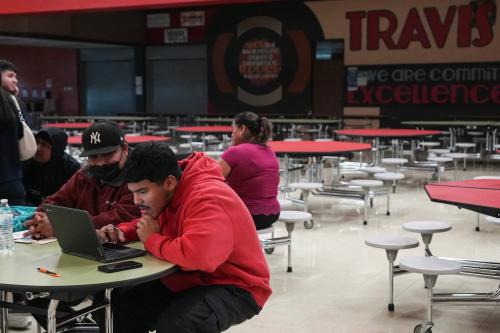If you want more content like this, subscribe to our newsletter.
This week in Class Notes:
- Check out my new newsletter, Of Boys and Men. Or buy my book. (Or, of course, both.)
- Evictions result from economic difficulties, but also cause them.
- Child penalties in employment and wages are twice as large for white women as Black women.
- Declining religious participation predicts more deaths of despair.
- This week’s top chart shows that children are likely to choose a field of study similar to their parents.
- Post-COVID, time for year-round schooling, says the Washington Post Editorial Board.
- Check out our new piece on the increasing costs of raising children.
- For your calendar: Virtual events on men and work in the post-pandemic era, COVID and willingness to work, and an aging workforce.
Of Boys and Men
Before diving into the usual Class Notes round-up, I wanted to point you towards another newsletter I’ve started, focused on boys and men. I’ll be writing there weekly, on a wide range of topics, including education, jobs, sex, wages, fatherhood, masculinity, politics, friendship, mental health, and much more. Please check it out. And if you like it, consider subscribing and sharing. Boys and men are now a major focus of my work: we have a new project here at Brookings on the topic. Oh, I also have a book on the subject coming out in a week or so: “Of Boys and Men: Why the Modern Male Is Struggling, Why It Matters, and What to Do about It.” Tyler Cowen says it is “one of the most important books, if not the most important book of the year.”
Child penalties in employment and wages are twice as large for white women as Black women
The gender pay gap is driven in large part by the “child penalty” faced by mothers, in terms of both reduced employment and lower earnings. But how does it differ by race? In a new paper comparing Black and white women, Jiaqi Li finds the long-run earnings penalty is twice as high for white women (44%) as for Black women (22%). Using data from the Panel Study of Income Dynamics, the author shows that penalties are driven by a combination of employment rates, hours worked and wages. Li finds that this Black-white difference is driven by women with wages above the female median and are married. As Li writes: “the racial gap is primarily driven by married white women having significantly larger child penalties than the other women.” Accounting for the earnings of husbands narrows the racial gap in the child penalty, but only by 24%. Li’s paper is the first to rule out explanations for the racial gap based on single parenthood, family structure, homeownership rates, or the attitude of husbands towards their wives working. Rather, the difference seems to be driven by some combination of discrimination and/or preferences.
Declining religious participation predicts more deaths of despair
The rise in “deaths of despair,” from drug use, suicide, or alcohol, has received a great deal of attention in recent years. A new paper from Tyler Giles, Daniel Hungerman and Tamar Oostrom finds that a decline in religious participation led to an increase in these deaths of despair. Most scholars have focused on the last two decades, especially given the rise in opioid use during that period. But the authors show that there’s a striking rise in deaths of despair in the 1990s. This trend is preceded by a decline in religious participation, especially among white middle-aged Americans without a college degree. States that had the largest declines in attendance had the largest increases in deaths of despair. Importantly, the effect is driven by drops in formal attendance and participation, rather than by any changes in personal beliefs or practices, such as prayer.
Evictions arise from economic difficulties but also cause them
Each year over two million households face an eviction order. In a recent working paper, Robert Collinson and co-authors find that eviction orders are both preceded and followed by adverse economic events. In the year leading up to the eviction filing, evicted tenants’ quarterly earnings drop by $337. In the year after the filing, evicted tenants’ earnings drop by $323. Those with deeper economic problems are most likely to be evicted. The eviction itself can then cause economic problems. But to what extent are these the result of the eviction itself, rather than a continuation of existing difficulties? Exploiting the random assignment of cases to judges of differing leniency, the authors attempt to show the causal impact of eviction. They find that evictions contribute to a cycle of poverty, where losing a home exacerbates the economic problems households were already facing. Evictions worsen access to credit due to increases in debt and lower credit scores, and cause an increase in hospital visits, including mental health related visits. The impact is especially sharp for Black and female tenants. These costs need to be included in any assessment of the costs and benefitsof housing policy.
Top chart: Children very likely to follow parental footsteps in their college field of study
Children are quite likely to study the same subject in college as their parents, everything else equal. The figure shows that this is especially true in fields such as technology, engineering, humanities, and medicine. (The author uses a regression discontinuity design to estimate the casual influence of parental degree choice on children).
 Source: Altmejd, 2022
Source: Altmejd, 2022
Choice opinion: Student test scores plummeted during the pandemic. What can schools do?
“Extra instructional time — whether tutoring, additional school days, extended school days or summer school — is key to helping students catch up. Congress has allocated $190 billion to schools to deal with the pandemic; those funds should be spent with extra teaching time in mind…Now would also be a good time for schools to jettison an outdated school calendar built around giving children summers off to work on the family farm and replace that with year-round schooling,” writes the Washington Post Editorial Board.
Self-promotion: Why it now costs more than $300,000 to raise a child
Inflation and weak government support for parents has made raising children much more expensive. Total expenditures on a child born in 2015 come out to be $310,605. Due to higher inflation, a middle-income married family with two kids is now spending $26,011 on raising kids to 17. These higher costs come at a time when attempts to provide additional support for parents through legislation such as Build Back Better have failed, and abortion restrictions are restricting choice, leaving women and parents to foot a bill they may not be prepared for.
For your calendar: Virtual events on men and work in the post-pandemic era, COVID and willingness to work, and an aging workforce
Men without work in the post-pandemic era
American Enterprise Institute
Monday, September 18, 2022
10:30 AM – 11:30 AM EDT
Has the willingness to work fallen during the COVID pandemic?
Federal Reserve Bank of Boston
Thursday, October 6, 2022
1:45 PM – 3:00 PM EDT
Overtime: America’s aging workforce and the future of working longer
Brookings Institution
Wednesday, September 21, 2022
10:00 AM – 11:30 AM EDT








Commentary
Class Notes: Boys and men, home evictions, and more
September 15, 2022